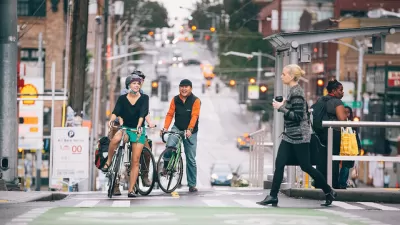As it winds down port operations in the area, Bergen plans to transform its Dokken district from a busy shipping hub to a car-free, 'regenerative' zone.

A coastal district of the Norwegian city of Bergen is preparing to become a zero-emissions neighborhood. As Adele Peters writes, "[t]he project is still in the planning stages, as the city runs workshops to involve residents in the creation of the neighborhood. But a new proposal illustrates what the area, which will include affordable housing, businesses, and other services, might look like."
With much of the land in the area owned by the city, Bergen leaders see this as "the opportunity of the century," a chance "to set high goals for what we want city development to be," says Laura Ve, who leads the development program for the Dokken district. The goal is to create a car-free zone "filled with people on foot and bikes" where "[e]verything is easily accessible based on low-impact mobility" and residents can easily connect to light rail and ferries.
"The design aims to create a 'regenerative' city, not just a sustainable one." The city plans to add new green space to "reconnect the public to the North Sea, with nature-based strategies used to protect the area from flooding caused by heavy storms, heat waves, and sea-level rise." While it's impossible to completely eliminate environmental impacts, the project aims to "find alternatives to fossil fuels in production, capture emissions, and even incorporate emissions into the finished product" for construction materials and "carefully calculate the full life cycle impacts of each decision."
Flemming Rafn, a founding partner at Tredje Natur, the Copenhagen-based architecture firm that worked on the project with designers at Entasis, Matter by Brix, and MOE, says, in addition to reducing carbon emissions, "the new neighborhood can demonstrate how tackling environmental challenges can also improve the local quality of life."
FULL STORY: How to redesign a neighborhood for zero emissions

Planetizen Federal Action Tracker
A weekly monitor of how Trump’s orders and actions are impacting planners and planning in America.

San Francisco's School District Spent $105M To Build Affordable Housing for Teachers — And That's Just the Beginning
SFUSD joins a growing list of school districts using their land holdings to address housing affordability challenges faced by their own employees.

The Tiny, Adorable $7,000 Car Turning Japan Onto EVs
The single seat Mibot charges from a regular plug as quickly as an iPad, and is about half the price of an average EV.

Seattle's Plan for Adopting Driverless Cars
Equity, safety, accessibility and affordability are front of mind as the city prepares for robotaxis and other autonomous vehicles.

As Trump Phases Out FEMA, Is It Time to Flee the Floodplains?
With less federal funding available for disaster relief efforts, the need to relocate at-risk communities is more urgent than ever.

With Protected Lanes, 460% More People Commute by Bike
For those needing more ammo, more data proving what we already knew is here.
Urban Design for Planners 1: Software Tools
This six-course series explores essential urban design concepts using open source software and equips planners with the tools they need to participate fully in the urban design process.
Planning for Universal Design
Learn the tools for implementing Universal Design in planning regulations.
Smith Gee Studio
City of Charlotte
City of Camden Redevelopment Agency
City of Astoria
Transportation Research & Education Center (TREC) at Portland State University
US High Speed Rail Association
City of Camden Redevelopment Agency
Municipality of Princeton (NJ)





























